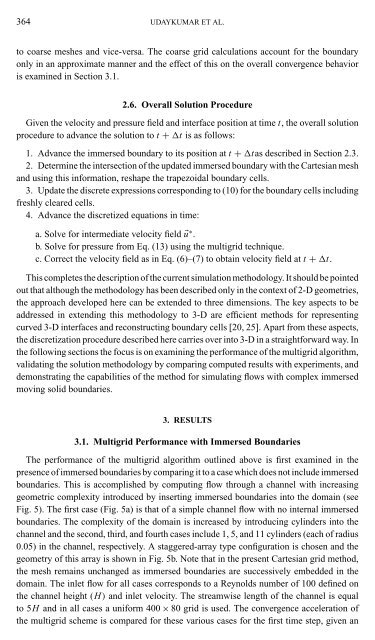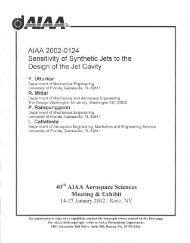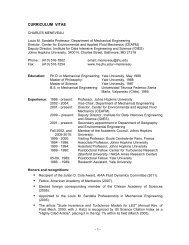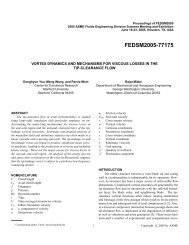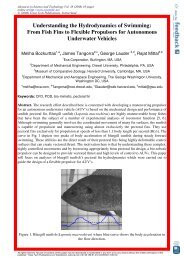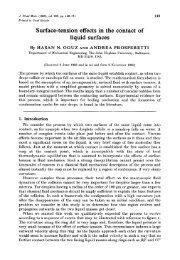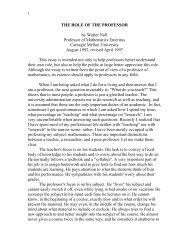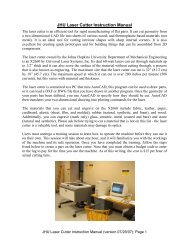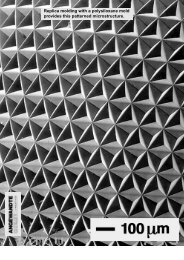A Sharp Interface Cartesian Grid Method for Simulating Flows with ...
A Sharp Interface Cartesian Grid Method for Simulating Flows with ...
A Sharp Interface Cartesian Grid Method for Simulating Flows with ...
Create successful ePaper yourself
Turn your PDF publications into a flip-book with our unique Google optimized e-Paper software.
364 UDAYKUMAR ET AL.<br />
to coarse meshes and vice-versa. The coarse grid calculations account <strong>for</strong> the boundary<br />
only in an approximate manner and the effect of this on the overall convergence behavior<br />
is examined in Section 3.1.<br />
2.6. Overall Solution Procedure<br />
Given the velocity and pressure field and interface position at time t, the overall solution<br />
procedure to advance the solution to t + t is as follows:<br />
1. Advance the immersed boundary to its position at t + tas described in Section 2.3.<br />
2. Determine the intersection of the updated immersed boundary <strong>with</strong> the <strong>Cartesian</strong> mesh<br />
and using this in<strong>for</strong>mation, reshape the trapezoidal boundary cells.<br />
3. Update the discrete expressions corresponding to (10) <strong>for</strong> the boundary cells including<br />
freshly cleared cells.<br />
4. Advance the discretized equations in time:<br />
a. Solve <strong>for</strong> intermediate velocity field ⃗u ∗ .<br />
b. Solve <strong>for</strong> pressure from Eq. (13) using the multigrid technique.<br />
c. Correct the velocity field as in Eq. (6)–(7) to obtain velocity field at t + t.<br />
This completes the description of the current simulation methodology. It should be pointed<br />
out that although the methodology has been described only in the context of 2-D geometries,<br />
the approach developed here can be extended to three dimensions. The key aspects to be<br />
addressed in extending this methodology to 3-D are efficient methods <strong>for</strong> representing<br />
curved 3-D interfaces and reconstructing boundary cells [20, 25]. Apart from these aspects,<br />
the discretization procedure described here carries over into 3-D in a straight<strong>for</strong>ward way. In<br />
the following sections the focus is on examining the per<strong>for</strong>mance of the multigrid algorithm,<br />
validating the solution methodology by comparing computed results <strong>with</strong> experiments, and<br />
demonstrating the capabilities of the method <strong>for</strong> simulating flows <strong>with</strong> complex immersed<br />
moving solid boundaries.<br />
3. RESULTS<br />
3.1. Multigrid Per<strong>for</strong>mance <strong>with</strong> Immersed Boundaries<br />
The per<strong>for</strong>mance of the multigrid algorithm outlined above is first examined in the<br />
presence of immersed boundaries by comparing it to a case which does not include immersed<br />
boundaries. This is accomplished by computing flow through a channel <strong>with</strong> increasing<br />
geometric complexity introduced by inserting immersed boundaries into the domain (see<br />
Fig. 5). The first case (Fig. 5a) is that of a simple channel flow <strong>with</strong> no internal immersed<br />
boundaries. The complexity of the domain is increased by introducing cylinders into the<br />
channel and the second, third, and fourth cases include 1, 5, and 11 cylinders (each of radius<br />
0.05) in the channel, respectively. A staggered-array type configuration is chosen and the<br />
geometry of this array is shown in Fig. 5b. Note that in the present <strong>Cartesian</strong> grid method,<br />
the mesh remains unchanged as immersed boundaries are successively embedded in the<br />
domain. The inlet flow <strong>for</strong> all cases corresponds to a Reynolds number of 100 defined on<br />
the channel height (H) and inlet velocity. The streamwise length of the channel is equal<br />
to 5H and in all cases a uni<strong>for</strong>m 400 × 80 grid is used. The convergence acceleration of<br />
the multigrid scheme is compared <strong>for</strong> these various cases <strong>for</strong> the first time step, given an


